|
Mangrove Cuckoo Coccyzus minor Cuclillo Manglero,
|
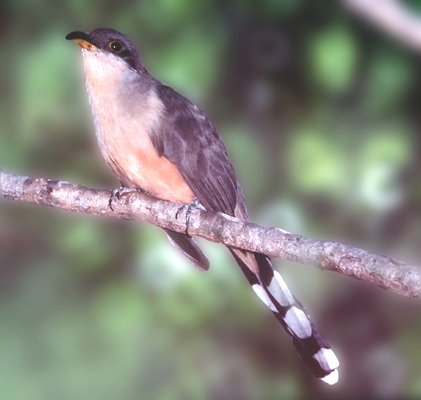 |
|
Photo: M. Oberle
|
|
Mangrove Cuckoo Coccyzus minor Cuclillo Manglero,
|
 |
|
Photo: M. Oberle
|
|
IDENTIFICATION: A slender bird with buffy or light yellow underparts, a gray cap, and a black facial mask. It has a long tail with prominent white spots underneath. Its thick bill is slightly curved. Length: 33 cm.; weight: 65 g. VOICE: The song is a series of 8-20, low-pitched, resonant notes that sound like an electric guitar. Audio (M. Oberle). HABITAT: Thick vegetation in mangroves, coastal scrub, mountain forests, limestone hills, and coffee plantations, especially at middle or lower altitudes. HABITS: The Mangrove Cuckoo, like other members of its family, moves deliberately in thickets and tangles looking for caterpillars, grasshoppers, crickets, cicadas, spiders, and insect larvae, as well as frogs, lizards, snails, berries, and the eggs and nestlings of small birds. It is one of the few birds that eats hairy caterpillars, and sometimes the stomach is lined with caterpillar spines stuck in the stomach wall. Although quite common, the Mangrove Cuckoo is often difficult to see because of its slow movements, unless it reveals its location by calling. However, the Mangrove Cuckoo seems relatively unafraid of humans, and will often allow close approach. Its nest is a thin twig platform on a horizontal tree limb and contains 2-3 blue-green eggs. STATUS AND CONSERVATION: A common, permanent resident in thickets and forests. RANGE: From southern Florida through most of the Antilles, and both coasts of Mexico and Central America, south to the mouth of the Amazon River. Regular at Guánica, Guajataca and Vega State Forests. TAXONOMY: CUCULIFORMES; CUCULIDAE; Coccyzinae |
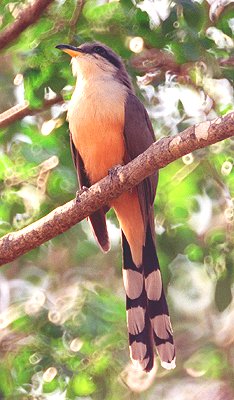 |
|
Photo: M. Oberle
|
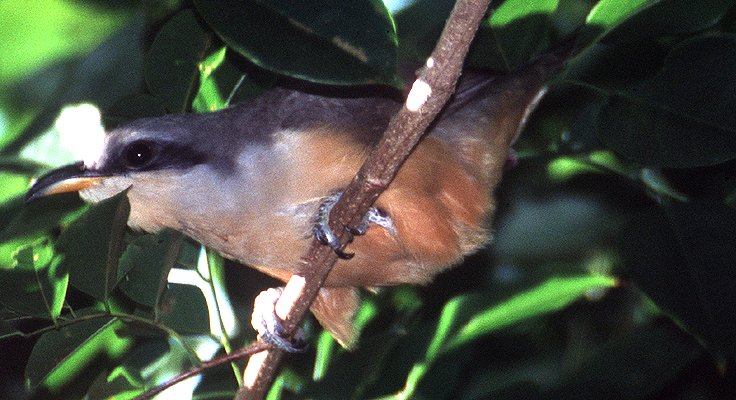 |
|
Photo: G. Beaton
|
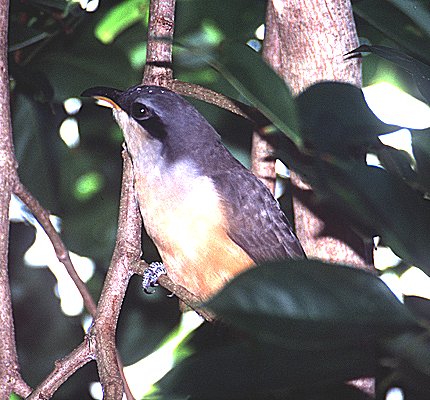 |
|
Photo: G. Beaton
|
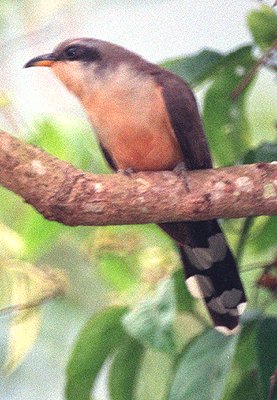 |
|
Photo: C. Ruiz
|
 |
|
Photo: G.Beaton
|
|
References Bent, A.C. 1940. Life histories of North American cuckoos, goatsuckers, hummingbirds and their allies. Smithsonian Instit. U.S. National Museum Bull. 176 (Reprinted by Dover Press, NY, 1964). Bradley, P. and Y. Rey-Millet. 1985. Birds of the Cayman Islands. P.E. Bradley, George Town, Grand Cayman. del Hoyo, J., A. Elliott, and J. Sargatal, eds. 1998. Handbook of Birds of the World, Vol. 4. Sandgrouse to cuckoos. Lynx Edicions, Barcelona. Hughes, J.M. 1997. Mangrove Cuckoo (Coccyzus minor). No. 299 in The birds of North America (A. Poole and F. Gill, eds.). Acad. Nat. Sci., Philadelphia, PA, and Am. Ornithol. Union, Washington, D.C. Hughes, J. M. 1999. Rare, local, little known, and declining North American breeders. A closer look: Mangrove Cuckoo. Birding 31:22-27. Raffaele, H.A. 1989. A guide to the birds of Puerto Rico and the Virgin Islands. Princeton. Raffaele, H.A. 1989. Una guía a las aves de Puerto Rico y las Islas Vírgenes. Publishing Resources, Inc., Santurce, PR. Raffaele, H.A., J.W. Wiley, O.H. Garrido, A.R. Keith, and J.I. Raffaele. 1998. Guide to the birds of the West Indies. Princeton. Next related species in taxonomic order Previous related species in taxonomic order |